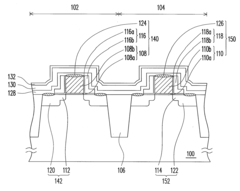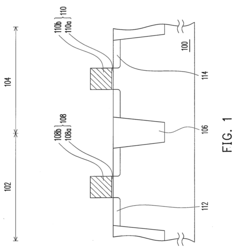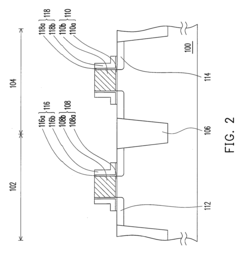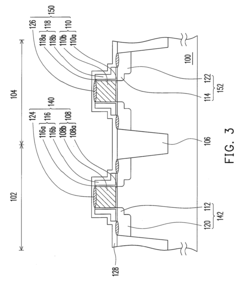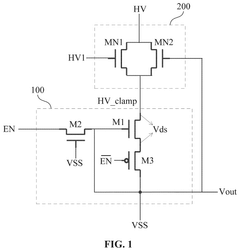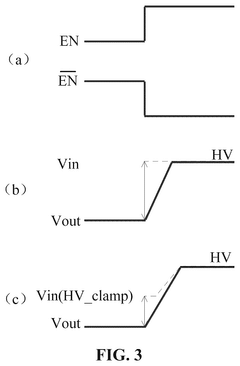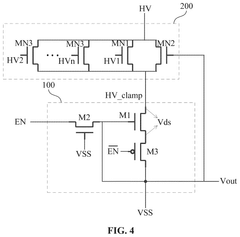Visualizing CMOS Battery Influence on Next-Level Technological Synergies
JUL 22, 20259 MIN READ
Generate Your Research Report Instantly with AI Agent
Patsnap Eureka helps you evaluate technical feasibility & market potential.
CMOS Battery Evolution
The evolution of CMOS battery technology has been a crucial factor in the advancement of modern electronics. Initially introduced in the 1980s, CMOS batteries have undergone significant transformations to meet the ever-increasing demands of technological synergies. The primary function of these batteries has remained consistent: to maintain system configuration settings and real-time clock information when the main power source is disconnected.
In the early stages, CMOS batteries were relatively large and had limited lifespan, often requiring replacement every few years. As technology progressed, manufacturers focused on improving energy density and longevity. The 1990s saw the introduction of lithium-based CMOS batteries, which offered superior performance and longer life compared to their predecessors. This shift marked a significant milestone in CMOS battery evolution, enabling more reliable and efficient operation of computer systems.
The turn of the millennium brought about further advancements in CMOS battery technology. Miniaturization became a key focus, driven by the trend towards smaller and more portable electronic devices. This led to the development of coin-cell batteries, which are now the standard form factor for CMOS applications. These compact batteries not only reduced the overall size of motherboards but also improved energy efficiency.
As we entered the 2010s, the emphasis shifted towards environmental sustainability and safety. Manufacturers began exploring alternatives to traditional lithium batteries, such as solid-state and rechargeable options. These new technologies aimed to address concerns about battery disposal and reduce the need for frequent replacements, aligning with the growing focus on eco-friendly electronics.
Recent years have seen a surge in research towards integrating CMOS batteries with energy harvesting technologies. This innovative approach aims to create self-sustaining power systems that can recharge using ambient energy sources such as light, heat, or vibration. While still in its early stages, this development holds promise for extending battery life indefinitely and reducing the environmental impact of electronic waste.
The evolution of CMOS batteries has also been closely tied to advancements in power management systems. Modern CMOS batteries work in conjunction with sophisticated power control circuits that optimize energy consumption and extend battery life. This synergy between battery technology and power management has been crucial in supporting the increasing complexity of computer systems and mobile devices.
Looking ahead, the future of CMOS battery evolution is likely to focus on further improvements in energy density, sustainability, and integration with emerging technologies. As we move towards more interconnected and power-hungry devices, the role of CMOS batteries in maintaining system integrity and enabling seamless operation will become even more critical. The ongoing research in nanotechnology and advanced materials is expected to drive the next wave of innovations in this field, potentially revolutionizing how we power and maintain our electronic systems.
In the early stages, CMOS batteries were relatively large and had limited lifespan, often requiring replacement every few years. As technology progressed, manufacturers focused on improving energy density and longevity. The 1990s saw the introduction of lithium-based CMOS batteries, which offered superior performance and longer life compared to their predecessors. This shift marked a significant milestone in CMOS battery evolution, enabling more reliable and efficient operation of computer systems.
The turn of the millennium brought about further advancements in CMOS battery technology. Miniaturization became a key focus, driven by the trend towards smaller and more portable electronic devices. This led to the development of coin-cell batteries, which are now the standard form factor for CMOS applications. These compact batteries not only reduced the overall size of motherboards but also improved energy efficiency.
As we entered the 2010s, the emphasis shifted towards environmental sustainability and safety. Manufacturers began exploring alternatives to traditional lithium batteries, such as solid-state and rechargeable options. These new technologies aimed to address concerns about battery disposal and reduce the need for frequent replacements, aligning with the growing focus on eco-friendly electronics.
Recent years have seen a surge in research towards integrating CMOS batteries with energy harvesting technologies. This innovative approach aims to create self-sustaining power systems that can recharge using ambient energy sources such as light, heat, or vibration. While still in its early stages, this development holds promise for extending battery life indefinitely and reducing the environmental impact of electronic waste.
The evolution of CMOS batteries has also been closely tied to advancements in power management systems. Modern CMOS batteries work in conjunction with sophisticated power control circuits that optimize energy consumption and extend battery life. This synergy between battery technology and power management has been crucial in supporting the increasing complexity of computer systems and mobile devices.
Looking ahead, the future of CMOS battery evolution is likely to focus on further improvements in energy density, sustainability, and integration with emerging technologies. As we move towards more interconnected and power-hungry devices, the role of CMOS batteries in maintaining system integrity and enabling seamless operation will become even more critical. The ongoing research in nanotechnology and advanced materials is expected to drive the next wave of innovations in this field, potentially revolutionizing how we power and maintain our electronic systems.
Market Demand Analysis
The market demand for visualizing CMOS battery influence on next-level technological synergies is driven by the increasing complexity of modern electronic systems and the critical role of power management in device performance. As electronic devices become more sophisticated and energy-efficient, there is a growing need for advanced tools and technologies that can accurately visualize and analyze the impact of CMOS batteries on overall system performance.
The semiconductor industry, in particular, has shown significant interest in this technology. With the continuous miniaturization of electronic components and the push for higher performance in smaller form factors, understanding the intricate relationships between power sources and system functionality has become crucial. This has led to a surge in demand for visualization tools that can provide real-time insights into how CMOS batteries affect various aspects of technological synergies.
In the consumer electronics sector, manufacturers are seeking ways to optimize battery life and performance in smartphones, tablets, and wearable devices. The ability to visualize CMOS battery influence can help in designing more efficient power management systems, ultimately leading to longer-lasting and better-performing products. This has created a substantial market opportunity for companies that can provide innovative visualization solutions.
The automotive industry is another key driver of market demand for this technology. As vehicles become increasingly electrified and autonomous, the need for sophisticated power management systems grows. Visualizing CMOS battery influence is essential for optimizing the performance of electric and hybrid vehicles, as well as for ensuring the reliability of advanced driver assistance systems (ADAS) and other critical components.
In the field of Internet of Things (IoT) and edge computing, where power efficiency is paramount, the demand for visualization tools is also on the rise. Companies developing IoT devices and edge computing solutions are looking for ways to maximize battery life and optimize power consumption, making visualization of CMOS battery influence a valuable asset in their development processes.
The healthcare and medical device industries have also shown interest in this technology. With the increasing prevalence of implantable and wearable medical devices, understanding and optimizing battery performance is crucial for patient safety and device longevity. Visualization tools that can accurately represent CMOS battery influence are in high demand for developing next-generation medical technologies.
As the global focus on sustainability and energy efficiency intensifies, the market for technologies that can help reduce power consumption and improve battery performance is expected to grow significantly. This trend is likely to further drive the demand for advanced visualization tools that can provide insights into CMOS battery influence on technological synergies across various industries and applications.
The semiconductor industry, in particular, has shown significant interest in this technology. With the continuous miniaturization of electronic components and the push for higher performance in smaller form factors, understanding the intricate relationships between power sources and system functionality has become crucial. This has led to a surge in demand for visualization tools that can provide real-time insights into how CMOS batteries affect various aspects of technological synergies.
In the consumer electronics sector, manufacturers are seeking ways to optimize battery life and performance in smartphones, tablets, and wearable devices. The ability to visualize CMOS battery influence can help in designing more efficient power management systems, ultimately leading to longer-lasting and better-performing products. This has created a substantial market opportunity for companies that can provide innovative visualization solutions.
The automotive industry is another key driver of market demand for this technology. As vehicles become increasingly electrified and autonomous, the need for sophisticated power management systems grows. Visualizing CMOS battery influence is essential for optimizing the performance of electric and hybrid vehicles, as well as for ensuring the reliability of advanced driver assistance systems (ADAS) and other critical components.
In the field of Internet of Things (IoT) and edge computing, where power efficiency is paramount, the demand for visualization tools is also on the rise. Companies developing IoT devices and edge computing solutions are looking for ways to maximize battery life and optimize power consumption, making visualization of CMOS battery influence a valuable asset in their development processes.
The healthcare and medical device industries have also shown interest in this technology. With the increasing prevalence of implantable and wearable medical devices, understanding and optimizing battery performance is crucial for patient safety and device longevity. Visualization tools that can accurately represent CMOS battery influence are in high demand for developing next-generation medical technologies.
As the global focus on sustainability and energy efficiency intensifies, the market for technologies that can help reduce power consumption and improve battery performance is expected to grow significantly. This trend is likely to further drive the demand for advanced visualization tools that can provide insights into CMOS battery influence on technological synergies across various industries and applications.
Technical Challenges
The visualization of CMOS battery influence on next-level technological synergies presents several significant technical challenges. One of the primary obstacles is the complexity of accurately modeling and representing the intricate relationships between CMOS battery performance and emerging technologies. The multifaceted nature of these interactions requires sophisticated simulation tools and advanced data processing capabilities that can handle large volumes of real-time data from diverse sources.
Another challenge lies in the development of intuitive and user-friendly interfaces that can effectively convey complex technical information to both experts and non-technical stakeholders. Creating visual representations that are both comprehensive and easily interpretable demands a delicate balance between detail and simplicity, often requiring innovative approaches to data visualization and interactive design.
The dynamic nature of technological synergies poses additional difficulties in visualization. As new technologies emerge and evolve rapidly, the visualization system must be adaptable and scalable to accommodate these changes. This necessitates the implementation of flexible architectures and algorithms capable of integrating new data sources and updating visual representations in real-time.
Furthermore, ensuring the accuracy and reliability of the visualized data presents a significant challenge. The influence of CMOS batteries on technological synergies often involves subtle interactions and dependencies that may be difficult to capture and quantify. Developing robust methodologies for data validation and error detection is crucial to maintain the integrity of the visualization system.
The issue of data security and privacy also emerges as a critical concern, particularly when dealing with sensitive technological information. Implementing secure data transmission protocols and access control mechanisms while maintaining the system's performance and usability requires careful consideration and advanced cybersecurity measures.
Lastly, the challenge of cross-platform compatibility and accessibility cannot be overlooked. Ensuring that the visualization tools function seamlessly across various devices and operating systems, while providing consistent user experiences, demands extensive development and testing efforts. This is particularly crucial in today's diverse technological landscape, where users may access the visualization system through a wide range of devices and platforms.
Another challenge lies in the development of intuitive and user-friendly interfaces that can effectively convey complex technical information to both experts and non-technical stakeholders. Creating visual representations that are both comprehensive and easily interpretable demands a delicate balance between detail and simplicity, often requiring innovative approaches to data visualization and interactive design.
The dynamic nature of technological synergies poses additional difficulties in visualization. As new technologies emerge and evolve rapidly, the visualization system must be adaptable and scalable to accommodate these changes. This necessitates the implementation of flexible architectures and algorithms capable of integrating new data sources and updating visual representations in real-time.
Furthermore, ensuring the accuracy and reliability of the visualized data presents a significant challenge. The influence of CMOS batteries on technological synergies often involves subtle interactions and dependencies that may be difficult to capture and quantify. Developing robust methodologies for data validation and error detection is crucial to maintain the integrity of the visualization system.
The issue of data security and privacy also emerges as a critical concern, particularly when dealing with sensitive technological information. Implementing secure data transmission protocols and access control mechanisms while maintaining the system's performance and usability requires careful consideration and advanced cybersecurity measures.
Lastly, the challenge of cross-platform compatibility and accessibility cannot be overlooked. Ensuring that the visualization tools function seamlessly across various devices and operating systems, while providing consistent user experiences, demands extensive development and testing efforts. This is particularly crucial in today's diverse technological landscape, where users may access the visualization system through a wide range of devices and platforms.
Current Solutions
01 CMOS battery power management
CMOS batteries play a crucial role in maintaining system settings and real-time clock functions in computers. Power management techniques are implemented to optimize battery life and ensure continuous operation of critical CMOS functions. This includes intelligent charging systems, power-saving modes, and voltage regulation to extend the lifespan of the CMOS battery.- CMOS battery power management: CMOS batteries play a crucial role in maintaining system settings and real-time clock functions when the main power is off. Power management techniques are implemented to optimize battery life and ensure reliable operation of CMOS-dependent systems. This includes monitoring battery voltage, implementing low-power modes, and providing backup power solutions.
- CMOS battery replacement and monitoring: Systems are designed to detect low CMOS battery conditions and facilitate easy replacement. This includes implementing battery monitoring circuits, providing user notifications for low battery conditions, and designing easily accessible battery compartments. Some systems also incorporate automatic backup mechanisms to preserve settings during battery replacement.
- CMOS battery influence on semiconductor devices: The CMOS battery's voltage and stability can affect the performance of semiconductor devices within electronic systems. This includes impacts on threshold voltages, leakage currents, and overall circuit stability. Design considerations are made to mitigate these effects and ensure consistent operation across varying battery conditions.
- CMOS battery in portable and mobile devices: In portable and mobile devices, CMOS batteries are critical for maintaining device functionality and user settings. Special considerations are made for size constraints, power efficiency, and integration with rechargeable main batteries. Some designs implement shared power systems or alternative energy storage solutions to enhance device portability and longevity.
- CMOS battery impact on system startup and recovery: The CMOS battery significantly influences system startup processes and recovery mechanisms. It affects the retention of BIOS settings, boot sequences, and system configurations. Advanced designs implement failsafe mechanisms and redundant power sources to ensure system integrity even in cases of CMOS battery failure.
02 CMOS battery failure detection and backup systems
Systems are designed to detect CMOS battery failures and implement backup solutions to prevent data loss. This includes monitoring battery voltage levels, implementing secondary power sources, and developing failsafe mechanisms to preserve critical system information in the event of a CMOS battery failure.Expand Specific Solutions03 CMOS battery impact on system performance
The state of the CMOS battery can significantly influence system performance and stability. Research focuses on understanding how battery condition affects boot times, system reliability, and overall computer functionality. This includes developing algorithms to predict battery life and optimize system performance based on battery health.Expand Specific Solutions04 CMOS battery replacement and hot-swapping technologies
Innovations in CMOS battery replacement techniques aim to minimize system downtime and data loss. This includes developing hot-swapping technologies that allow for battery replacement without powering down the system, as well as designing easily accessible battery compartments for quick and efficient replacements.Expand Specific Solutions05 CMOS battery integration with emerging technologies
Research explores the integration of CMOS batteries with emerging technologies such as IoT devices, wearable technology, and energy harvesting systems. This includes developing miniaturized CMOS batteries, implementing energy-efficient designs, and exploring alternative power sources to complement or replace traditional CMOS batteries in modern electronic devices.Expand Specific Solutions
Key Industry Players
The visualization of CMOS battery influence on next-level technological synergies is an emerging field in a rapidly evolving market. The industry is in its early growth stage, with significant potential for expansion as the importance of power management in advanced technologies increases. The market size is expected to grow substantially, driven by the increasing integration of CMOS batteries in various electronic devices and systems. In terms of technological maturity, companies like Samsung SDI, LG Energy Solution, and SK On are leading the charge with advanced battery technologies. Other players such as STMicroelectronics, NXP Semiconductors, and Texas Instruments are contributing to the development of integrated circuits and semiconductor solutions that enhance CMOS battery performance and visualization capabilities.
Samsung SDI Co., Ltd.
Technical Solution: Samsung SDI has developed cutting-edge CMOS battery management systems that leverage their expertise in battery cell technology and semiconductor manufacturing. Their solution integrates advanced sensing and control circuits directly into battery cells, enabling highly accurate and responsive management of battery parameters[7]. Samsung's approach utilizes machine learning algorithms to continuously optimize charging and discharging profiles, maximizing battery life and performance. The company has also pioneered the use of silicon anodes in their battery cells, which synergizes with their CMOS management system to achieve higher energy densities and faster charging capabilities[8]. Samsung SDI's holistic approach to battery and management system co-design allows for unprecedented levels of integration and efficiency.
Strengths: Vertical integration from battery cell production to management systems. Strong R&D capabilities in both battery chemistry and electronics. Weaknesses: Heavy focus on large-scale applications may limit adaptability to some niche markets.
LG Energy Solution Ltd.
Technical Solution: LG Energy Solution has developed an innovative CMOS battery management system that focuses on enhancing the performance and longevity of lithium-ion batteries. Their approach utilizes advanced CMOS circuits for precise voltage and current monitoring, combined with proprietary algorithms for accurate state-of-charge estimation[9]. LG's solution incorporates adaptive thermal management techniques that optimize battery performance across a wide range of operating conditions. The company has also developed novel cell balancing technologies that extend battery pack life and improve overall system efficiency[10]. LG Energy Solution's CMOS battery management system is designed to seamlessly integrate with their high-performance battery cells, creating a synergistic ecosystem that maximizes energy density and cycle life.
Strengths: Extensive experience in large-scale battery production and management. Strong presence in electric vehicle and energy storage markets. Weaknesses: May face challenges in adapting to rapidly evolving battery chemistries and form factors.
Core Innovations
Complementary metal-oxide-semiconductor transistor and method of fabricating the same
PatentInactiveUS20080237734A1
Innovation
- A method involving the formation of device isolation structures, conductive type MOS transistors with specific gate and doped regions, nitride spacers, and stress layers, where the thickness of nitride spacers is reduced through an etching process to increase stress in the channel region, particularly for N-type MOS transistors, to enhance driving current gain and overall device performance.
Complementary metal oxide semiconductor circuit of memory device
PatentPendingUS20250061952A1
Innovation
- The integration of an auxiliary clamping circuit between the input high-voltage and the MOS transistor in the high-voltage functional circuit, which clamps the voltage input during the rising phase of the output voltage, reducing the drain-source voltage and mitigating hot carrier injection effects.
Power Management Strategies
Power management strategies play a crucial role in optimizing the performance and longevity of CMOS batteries, which are integral to maintaining system configurations and real-time clock functions in modern computing devices. As we explore the influence of CMOS batteries on next-level technological synergies, it is essential to consider advanced power management techniques that can enhance overall system efficiency and reliability.
One key strategy in CMOS battery power management is the implementation of intelligent power gating. This technique involves selectively shutting down portions of the circuit that are not in use, effectively reducing power consumption and extending battery life. By utilizing sophisticated algorithms to predict usage patterns, power gating can be dynamically adjusted to balance performance requirements with energy conservation.
Another important approach is the adoption of adaptive voltage scaling (AVS). This method allows for real-time adjustment of the voltage supplied to the CMOS battery and associated circuitry based on the current workload and environmental conditions. By fine-tuning the voltage levels, AVS can significantly reduce power consumption during periods of low activity while ensuring adequate power supply during high-demand scenarios.
The integration of energy harvesting technologies presents an innovative strategy for CMOS battery power management. By capturing and converting ambient energy sources such as light, heat, or vibration into electrical energy, these systems can supplement or even replace traditional battery power in certain applications. This approach not only extends the operational life of CMOS batteries but also contributes to more sustainable and environmentally friendly technological solutions.
Advanced power management also involves the implementation of sophisticated battery monitoring and diagnostics systems. These systems utilize machine learning algorithms to analyze battery performance data, predict potential failures, and optimize charging cycles. By providing real-time insights into battery health and performance, these monitoring systems enable proactive maintenance and replacement strategies, minimizing downtime and enhancing overall system reliability.
Furthermore, the development of ultra-low-power design techniques for CMOS circuits is a critical aspect of power management strategies. This includes the use of sub-threshold operation, where transistors are operated below their threshold voltage to minimize power consumption. While this approach may sacrifice some performance, it can lead to significant energy savings in applications where ultra-low power consumption is paramount.
In conclusion, effective power management strategies for CMOS batteries are essential for realizing the full potential of next-level technological synergies. By combining intelligent power gating, adaptive voltage scaling, energy harvesting, advanced monitoring systems, and ultra-low-power design techniques, we can significantly enhance the efficiency, reliability, and sustainability of CMOS battery-powered systems across a wide range of applications.
One key strategy in CMOS battery power management is the implementation of intelligent power gating. This technique involves selectively shutting down portions of the circuit that are not in use, effectively reducing power consumption and extending battery life. By utilizing sophisticated algorithms to predict usage patterns, power gating can be dynamically adjusted to balance performance requirements with energy conservation.
Another important approach is the adoption of adaptive voltage scaling (AVS). This method allows for real-time adjustment of the voltage supplied to the CMOS battery and associated circuitry based on the current workload and environmental conditions. By fine-tuning the voltage levels, AVS can significantly reduce power consumption during periods of low activity while ensuring adequate power supply during high-demand scenarios.
The integration of energy harvesting technologies presents an innovative strategy for CMOS battery power management. By capturing and converting ambient energy sources such as light, heat, or vibration into electrical energy, these systems can supplement or even replace traditional battery power in certain applications. This approach not only extends the operational life of CMOS batteries but also contributes to more sustainable and environmentally friendly technological solutions.
Advanced power management also involves the implementation of sophisticated battery monitoring and diagnostics systems. These systems utilize machine learning algorithms to analyze battery performance data, predict potential failures, and optimize charging cycles. By providing real-time insights into battery health and performance, these monitoring systems enable proactive maintenance and replacement strategies, minimizing downtime and enhancing overall system reliability.
Furthermore, the development of ultra-low-power design techniques for CMOS circuits is a critical aspect of power management strategies. This includes the use of sub-threshold operation, where transistors are operated below their threshold voltage to minimize power consumption. While this approach may sacrifice some performance, it can lead to significant energy savings in applications where ultra-low power consumption is paramount.
In conclusion, effective power management strategies for CMOS batteries are essential for realizing the full potential of next-level technological synergies. By combining intelligent power gating, adaptive voltage scaling, energy harvesting, advanced monitoring systems, and ultra-low-power design techniques, we can significantly enhance the efficiency, reliability, and sustainability of CMOS battery-powered systems across a wide range of applications.
Environmental Impact
The environmental impact of CMOS battery technology and its influence on next-level technological synergies is a critical aspect to consider in the development and implementation of advanced computing systems. CMOS batteries, while small in size, play a significant role in maintaining system configurations and real-time clock functions in various electronic devices.
From a manufacturing perspective, the production of CMOS batteries involves the use of lithium and other materials that require careful extraction and processing. The mining and refining of these materials can lead to habitat disruption, water pollution, and increased carbon emissions. However, the long lifespan of CMOS batteries, typically ranging from 2 to 10 years, helps mitigate the frequency of replacement and associated environmental costs.
In terms of energy consumption, CMOS batteries contribute to the overall power efficiency of electronic devices. By maintaining system settings during power-off states, they reduce the need for reconfiguration and minimize boot-up times, potentially leading to energy savings over the device's lifetime. This efficiency can translate to reduced electricity consumption and, consequently, lower carbon emissions from power generation.
The disposal of CMOS batteries presents another environmental challenge. As electronic waste, these batteries contain hazardous materials that can leach into soil and water systems if not properly handled. Implementing effective recycling programs for CMOS batteries is crucial to recover valuable materials and prevent environmental contamination.
When considering the synergies with next-level technologies, CMOS batteries play a role in enabling more sophisticated power management systems. These advancements can lead to the development of ultra-low-power devices and improved energy harvesting technologies, potentially reducing the overall environmental footprint of electronic systems.
Furthermore, the integration of CMOS battery technology with emerging sustainable materials and manufacturing processes offers opportunities for reducing environmental impact. Research into biodegradable components and eco-friendly production methods could significantly improve the life-cycle assessment of CMOS batteries and their associated technologies.
In conclusion, while CMOS batteries present certain environmental challenges, their role in enabling efficient and long-lasting electronic systems contributes to overall sustainability efforts in the tech industry. Continued research and development in this field should focus on minimizing negative environmental impacts while maximizing the potential for technological synergies that promote energy efficiency and sustainable computing practices.
From a manufacturing perspective, the production of CMOS batteries involves the use of lithium and other materials that require careful extraction and processing. The mining and refining of these materials can lead to habitat disruption, water pollution, and increased carbon emissions. However, the long lifespan of CMOS batteries, typically ranging from 2 to 10 years, helps mitigate the frequency of replacement and associated environmental costs.
In terms of energy consumption, CMOS batteries contribute to the overall power efficiency of electronic devices. By maintaining system settings during power-off states, they reduce the need for reconfiguration and minimize boot-up times, potentially leading to energy savings over the device's lifetime. This efficiency can translate to reduced electricity consumption and, consequently, lower carbon emissions from power generation.
The disposal of CMOS batteries presents another environmental challenge. As electronic waste, these batteries contain hazardous materials that can leach into soil and water systems if not properly handled. Implementing effective recycling programs for CMOS batteries is crucial to recover valuable materials and prevent environmental contamination.
When considering the synergies with next-level technologies, CMOS batteries play a role in enabling more sophisticated power management systems. These advancements can lead to the development of ultra-low-power devices and improved energy harvesting technologies, potentially reducing the overall environmental footprint of electronic systems.
Furthermore, the integration of CMOS battery technology with emerging sustainable materials and manufacturing processes offers opportunities for reducing environmental impact. Research into biodegradable components and eco-friendly production methods could significantly improve the life-cycle assessment of CMOS batteries and their associated technologies.
In conclusion, while CMOS batteries present certain environmental challenges, their role in enabling efficient and long-lasting electronic systems contributes to overall sustainability efforts in the tech industry. Continued research and development in this field should focus on minimizing negative environmental impacts while maximizing the potential for technological synergies that promote energy efficiency and sustainable computing practices.
Unlock deeper insights with Patsnap Eureka Quick Research — get a full tech report to explore trends and direct your research. Try now!
Generate Your Research Report Instantly with AI Agent
Supercharge your innovation with Patsnap Eureka AI Agent Platform!
